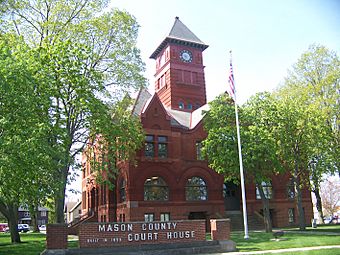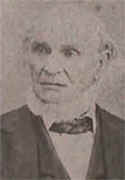Mason County Courthouse (Michigan) facts for kids
|
Mason County Courthouse
|
|
 |
|
| Location | 300 E. Ludingon Avenue Ludington, Michigan |
|---|---|
| Built | 1893-94 |
| Architect | Sidney J. Osgood |
| Architectural style | Richardsonian Romanesque |
| NRHP reference No. | 88000602 |
Quick facts for kids Significant dates |
|
| Added to NRHP | February 24, 1988 |
The Mason County Courthouse is an important building in Mason County, Michigan. It is located in the town of Ludington, which is in the Lower Peninsula of Michigan. This courthouse is where many important decisions for the county are made, and it has a long and interesting history.
Contents
A Look Back: The Courthouse Story
The area around Mason County first attracted people because of its many white pine trees. These trees were perfect for lumber. Some of the first people to settle here were lumbermen like Burr Caswell, Charles Mears, James Ludington, and Eber Brock Ward.
The First Courthouse: A Farmhouse
Burr Caswell moved to the area in 1847 from New York. In 1849, he built a house from wood he found, which was the first wooden building in Mason County. This house is still around today at White Pine Village.
Caswell's farmhouse became the very first official county seat and courthouse. He moved his family upstairs so the first floor could be used for county business and even a trading post. There was even a jail below the house! The Mason County Historical Society has since fixed up Caswell's house, and it is now part of "Historic White Pine Village." Before the current courthouse was built in 1893, there were two other buildings that served as the county's courthouse.
Moving the County Seat
Mason County officially started in 1855. At that time, Burr Caswell's farmhouse was chosen as the official county seat and courthouse. Before this, the area was just an unofficial settlement in the northwest part of Michigan's Lower Peninsula.
The Caswell farmhouse was the county courthouse until 1861. Then, the county seat moved to a place called Little Sable (which later became Lincoln Village). In 1873, the county seat moved permanently to the town of Pere Marquette. This town was later renamed "Ludington" after James Ludington, a wealthy businessman who helped develop it. The town became a city in the same year. The courthouse built in 1873 was made of brick and located on E. Pere Marquette Street. The land for it was given by Charles Resseguie.
The Courthouse Today
The building you see today was constructed between 1893 and 1894. It's a multi-story building with a tall clock tower. The clock in the tower was made by Nels Johnson in 1907.
Building Design and Materials
The courthouse was designed by an architect named Sidney J. Osgood from Grand Rapids, Michigan. It's built in a style called Richardsonian Romanesque, which often uses heavy stone and round arches. The building is made from Jacobsville sandstone, a special type of stone from Houghton County in Michigan's Upper Peninsula.
This courthouse is very important! It is listed on the National Register of Historic Places and is also a Michigan Registered Site.
The Clock's Special Chime
Since October 2010, the clock in the tower has done something unusual. At 1 o'clock, day or night, the clock bell strikes thirteen times instead of just once!
Honoring History: State Historical Marker
On May 18, 2000, the Mason County Historical Society announced that the Mason County Courthouse had received a special State Historical Marker. This marker is like a sign that tells important facts about a place.
Unveiling the Marker
There was a special event on June 14, 2000, to officially show the marker. It was placed on the lawn of the courthouse in downtown Ludington, Michigan. This marker means that the State of Michigan believes the courthouse is important enough to be preserved for the future.
The current courthouse was added to the National Register of Historic Sites on February 24, 1988. It was also added to the State Register of Historic Sites on August 15, 1975. The building celebrated its 100th birthday on September 18, 1994.
The very first Mason County Courthouse, which was Burr Caswell's farmhouse at White Pine Village, also received a historical marker in 1986. It was added to the State Register of Historic Sites on May 17, 1978.
What the Marker Says
The official historical marker placed at the courthouse tells its story:
The first permanent Euro-American settlement in Mason County began in 1847 when New York native Burr Caswell and his family arrived at the mouth of the Pere Marquette River. The Caswells lived in a driftwood cabin near the Ottawa village of Nindebekatunning. Abundant pine forests attracted lumbermen including Charles Mears, James Ludington, and Eber Brock Ward. In 1855 the state legislature organized Mason County, named for Michigan's first governor, Stevens T. Mason. The Caswell farmhouse in Pere Marquette Township served as the county seat. In 1860, Charles Mears persuaded the board to remove the county seat to Little Sauble (later Lincoln). But remote Little Sauble could not compete with booming Ludington. In 1873 Ludington became the permanent county seat.
Ludington became the Mason county seat in 1873, when county offices were moved from the now-vanished village of Little Sauble. At that time Ludington was the county's most prosperous settlement. Formerly called Pere Marquette, Ludington was platted in 1867 by Milwaukee lumberman James Ludington. The town served as a shipping center for West Michigan lumber. Erected in 1893-94, this is the fourth structure to serve as Mason County's courthouse since the county was established in 1855. Grand Rapids architect Sidney J. Osgood designed the Richardsonian Romanesque structure, which was built of Jacobsville sandstone from the Upper Peninsula. The courthouse is listed in the National Register of Historic Places.
Images for kids
-
Burr Caswell farmhouse now at White Pine Village
















